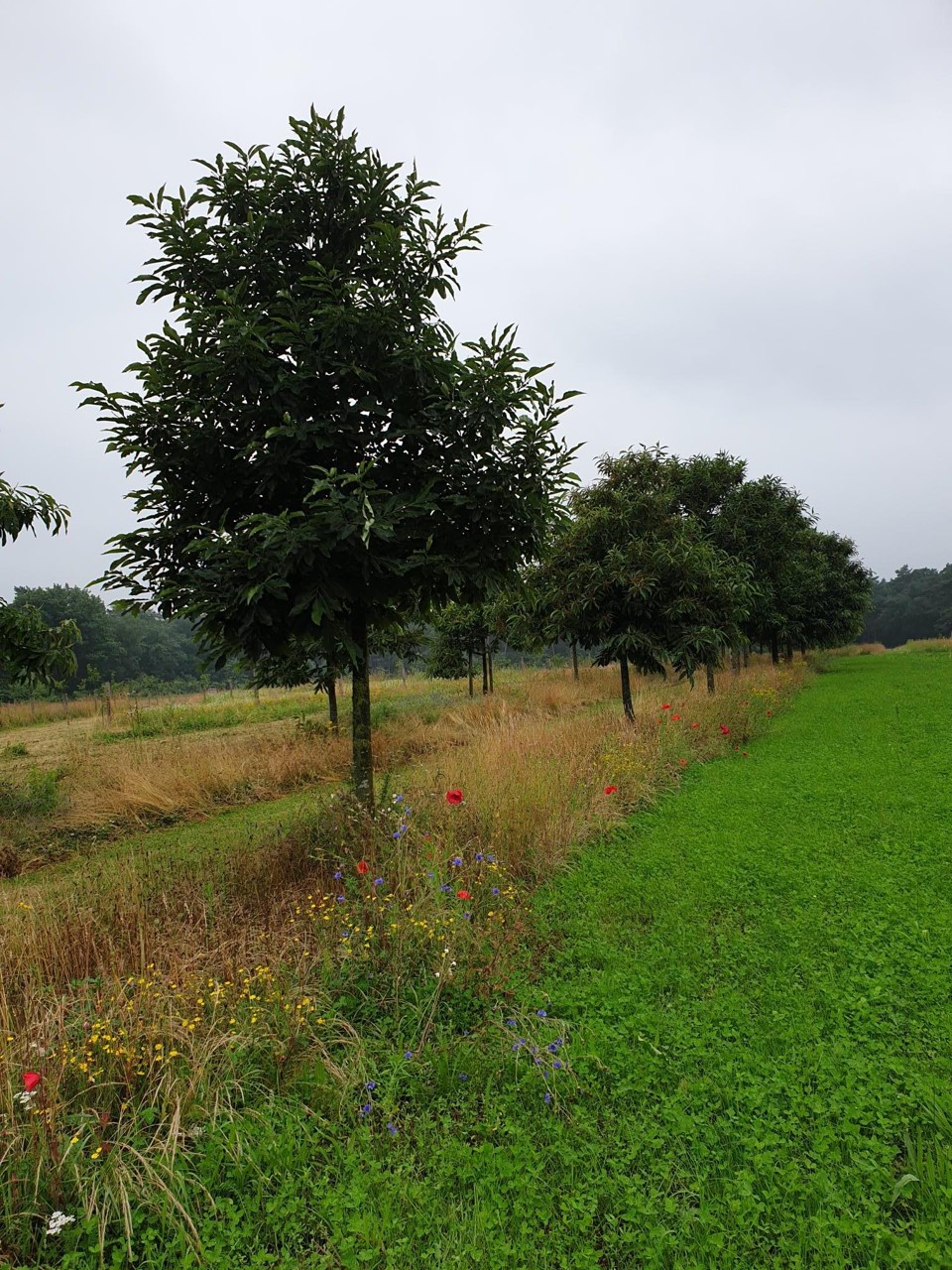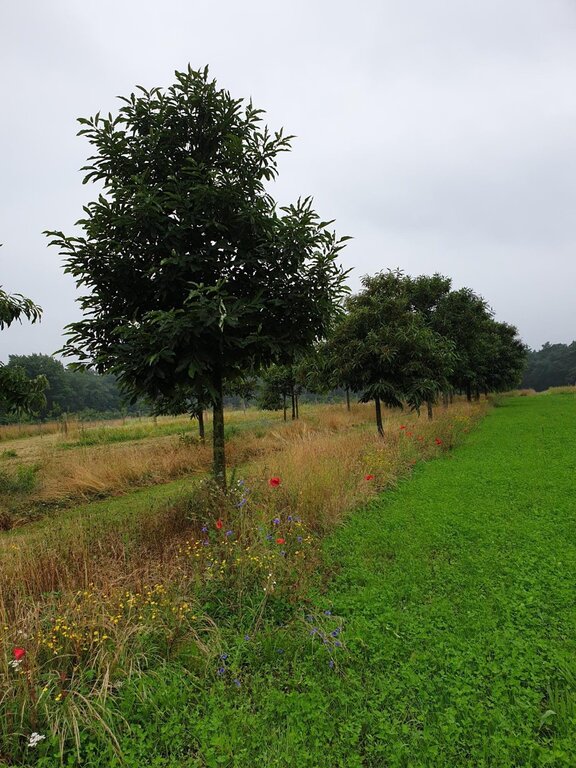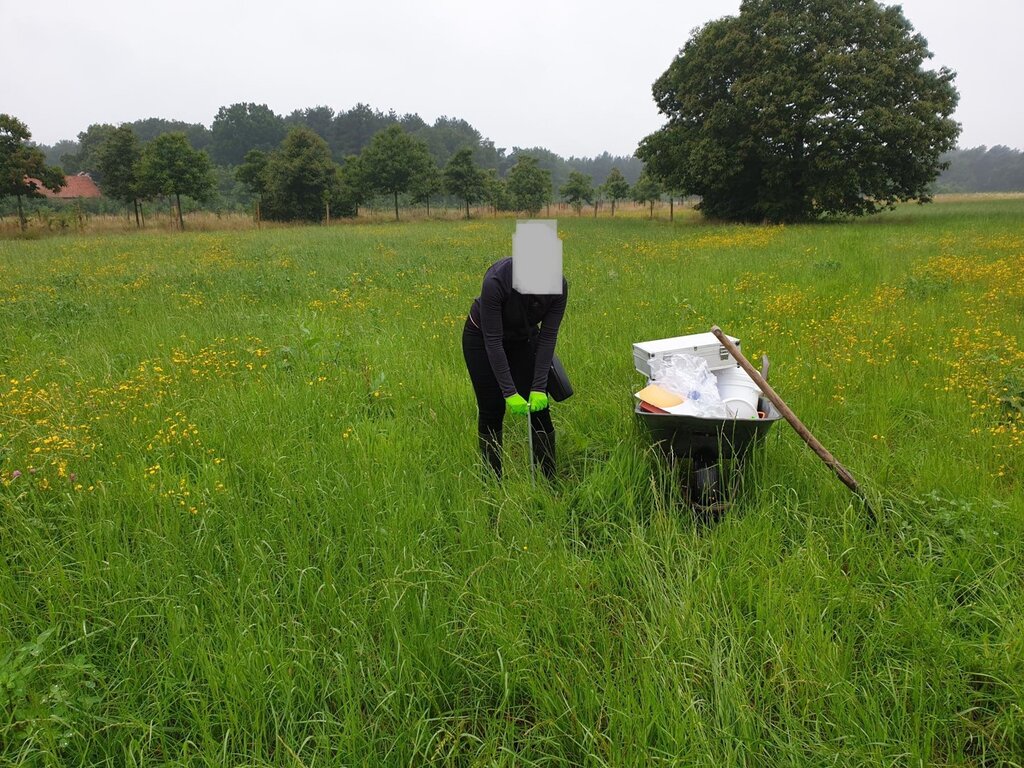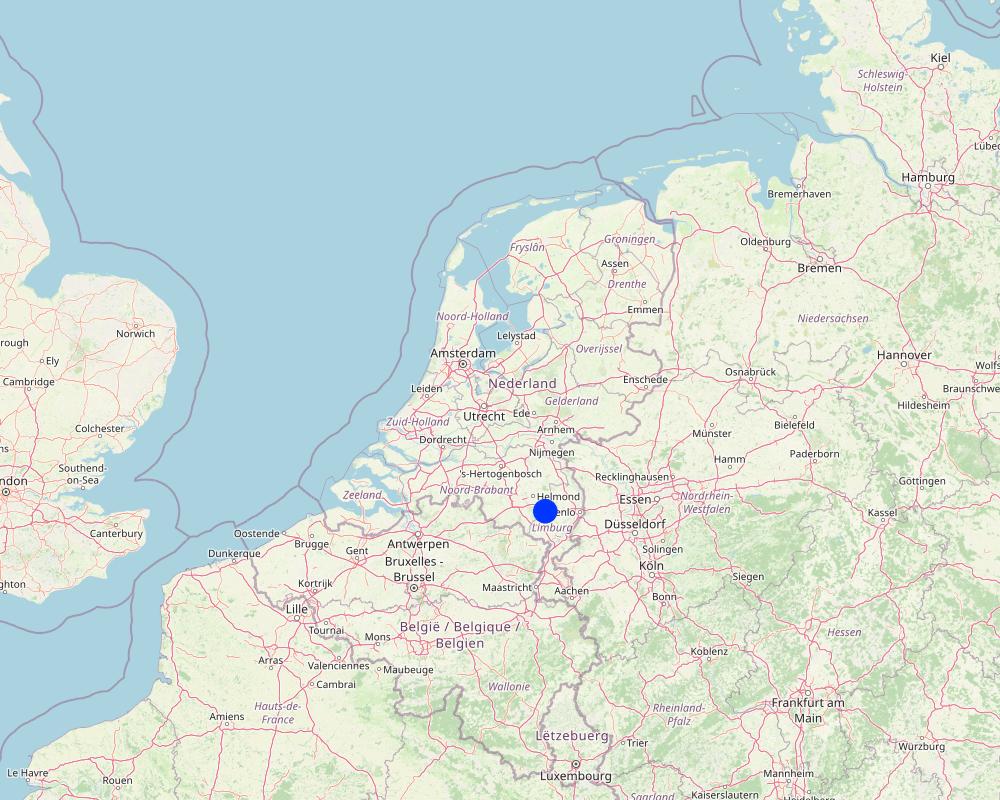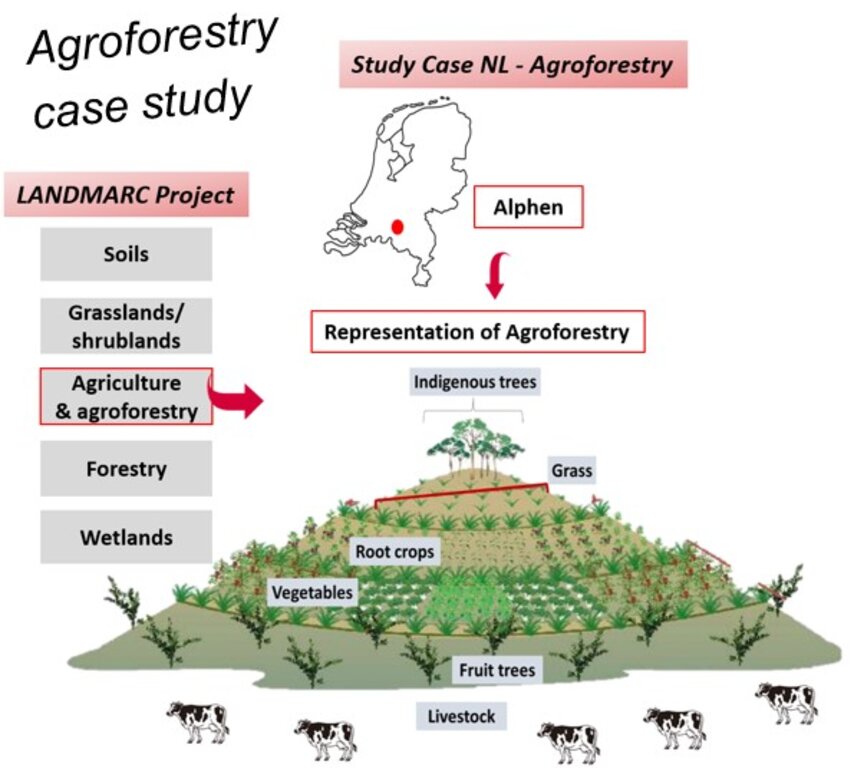Alley cropping with nut trees [Netherlands]
- Creation:
- Update:
- Compiler: Carlos Gil Picon
- Editor: –
- Reviewers: Rima Mekdaschi Studer, William Critchley
Alley cropping with nut trees
technologies_7094 - Netherlands
View sections
Expand all Collapse all1. General information
1.2 Contact details of resource persons and institutions involved in the assessment and documentation of the Technology
Key resource person(s)
SLM specialist:
Gil Picon Carlos
Stichting Joint Implementation Network
Netherlands
Name of project which facilitated the documentation/ evaluation of the Technology (if relevant)
Land Use Based Mitigation for Resilient Climate Pathways (LANDMARC)Name of the institution(s) which facilitated the documentation/ evaluation of the Technology (if relevant)
JIN Climate and Sustainability (JIN-NGO) - Netherlands1.3 Conditions regarding the use of data documented through WOCAT
The compiler and key resource person(s) accept the conditions regarding the use of data documented through WOCAT:
Yes
1.4 Declaration on sustainability of the described Technology
Is the Technology described here problematic with regard to land degradation, so that it cannot be declared a sustainable land management technology?
No
2. Description of the SLM Technology
2.1 Short description of the Technology
Definition of the Technology:
An agroforestry system consisting of rows of walnut and hazelnut trees combined with grassland and flowers was applied in place of a former conventional monoculture system in Alphen, Noord-Brabant, the Netherlands.
2.2 Detailed description of the Technology
Description:
This agroforestry technology is applied on an organic farm located in the province of Noord-Brabant, Netherlands. Owned by a local farmer, the farm covers a total of 7.8 hectares. In 2018, this land was allocated for the Farm Life project, transforming it into agroforestry system. The farm integrates natural and agricultural elements, creating a sustainable environment where trees (chestnuts), crops, and pasture co-exist.
The agroforestry system on this farm is utilized for multiple purposes, including chestnut tree cultivation, agriculture, horticulture, and pasture. This diverse planting strategy allows the farmer to mix crop production with tree cultivation, where each component supports soil health and ecological balance. Chestnut trees, for example, are grown alongside mainly grasses, introducing perennial elements to the farm and diversifying the landscape.
Agroforestry merges natural ecosystems with agriculture, creating a system where nature actively enhances farm productivity. It allows farmers to move beyond monoculture farming by incorporating trees and shrubs into crop systems, promoting biodiversity as an essential part of farming. For example, integrating chestnut trees into these systems improves soil health, reduces erosion (as these are mainly sandy soils), and strengthens the farm’s resilience to environmental stress. This approach also creates income from products like chestnuts, which supports sustainable food production—a primary motivation for the farmer.
This agroforestry system, while beneficial, faces challenges in implementation and scaling-up. For example, perennial food crops are not yet commonly integrated into modern agroforestry systems, which limits their full potential. Establishing a guide on cultivation practices and securing better funding would be key steps to upscaling agroforestry production and making it more accessible. Additionally, adequate resources and guidance on plant selection, tree management, and harvesting methods would make it easier for farmers to adopt and sustain these practices.
Specifically to this agroforestry, compared to traditional fruit trees like apples and pears, chestnut trees require less intensive management—reducing labor as they naturally drop fruit and need less pruning. They also enhance biodiversity and can be financially beneficial. As a perennial carbohydrate source, chestnuts offer a sustainable, low-maintenance crop option that aligns with modern food production goals. Additionally, they can help revitalize traditional orchard landscapes and accelerate returns from forest areas through nut production, contributing to long-term ecological and economic benefits.
While agroforestry offers many environmental benefits, land users face several challenges. Initial investments in tree planting, maintenance, and management can be costly, and limited access to financial support often discourages smallholder farmers from adopting these practices. Some farmers also find the high diversity of species in agroforestry systems to be complex and challenging for achieving consistent product yields. There are also limitations in technology suited for small-scale agroforestry, such as a shortage of plant materials (e.g., seedlings) and limited guidance on establishing and maintaining agroforestry systems. On the positive side, farmers appreciate agroforestry’s contributions to a sustainable environment. The increased organic matter and diversity, improve soil health and crop productivity, and build resilience against environmental stressors, which makes agroforestry an option for long-term land management.
2.3 Photos of the Technology
2.5 Country/ region/ locations where the Technology has been applied and which are covered by this assessment
Country:
Netherlands
Region/ State/ Province:
Noord-Brabant
Further specification of location:
Alphen
Specify the spread of the Technology:
- evenly spread over an area
If the Technology is evenly spread over an area, specify area covered (in km2):
0.078
Is/are the technology site(s) located in a permanently protected area?
No
Map
×2.6 Date of implementation
If precise year is not known, indicate approximate date:
- less than 10 years ago (recently)
2.7 Introduction of the Technology
Specify how the Technology was introduced:
- through land users' innovation
3. Classification of the SLM Technology
3.1 Main purpose(s) of the Technology
- reduce, prevent, restore land degradation
- conserve ecosystem
- adapt to climate change/ extremes and its impacts
- mitigate climate change and its impacts
3.2 Current land use type(s) where the Technology is applied
Land use mixed within the same land unit:
Yes
Specify mixed land use (crops/ grazing/ trees):
- Agroforestry

Cropland
- Tree and shrub cropping
Tree and shrub cropping - Specify crops:
- tree nuts (brazil nuts, pistachio, walnuts, almonds, etc.)
Number of growing seasons per year:
- 1
Is intercropping practiced?
Yes
Is crop rotation practiced?
No

Grazing land
Animal type:
- cattle - dairy
Products and services:
- milk

Other
Specify:
flowers
3.3 Has land use changed due to the implementation of the Technology?
Has land use changed due to the implementation of the Technology?
- Yes (Please fill out the questions below with regard to the land use before implementation of the Technology)

Cropland
- Annual cropping
Annual cropping - Specify crops:
- root/tuber crops - potatoes
Is intercropping practiced?
No
Is crop rotation practiced?
No
3.4 Water supply
Water supply for the land on which the Technology is applied:
- rainfed
3.5 SLM group to which the Technology belongs
- agroforestry
3.6 SLM measures comprising the Technology

vegetative measures
- V1: Tree and shrub cover
- V2: Grasses and perennial herbaceous plants

management measures
- M1: Change of land use type
3.7 Main types of land degradation addressed by the Technology

soil erosion by water
- Wt: loss of topsoil/ surface erosion

biological degradation
- Bh: loss of habitats
- Bp: increase of pests/ diseases, loss of predators

water degradation
- Hq: decline of groundwater quality
Comments:
The implementation of agroforestry in this case study intends to increase soil properties by restoring soil biological cycles, providing habitat for predators that can reduce pests, and reduce nitrate leaching to improve nutrient retention and avoid the leaching of nitrates.
3.8 Prevention, reduction, or restoration of land degradation
Specify the goal of the Technology with regard to land degradation:
- prevent land degradation
- reduce land degradation
4. Technical specifications, implementation activities, inputs, and costs
4.1 Technical drawing of the Technology
Technical specifications (related to technical drawing):
The system consists of a flat area of around 7.8ha where nut tree alleys have been implemented. The separation between tree lines is about 50 meters, and the separation between trees is around 12 meters.
Author:
Afnan Suleiman and Eline Keuning
Date:
15/07/2024
Technical specifications (related to technical drawing):
This case study consists of 3 plots where agroforestry was implemented; in the first two plots, trees are combined with grasslands and flowers. The combined length of these two plots is 350 meters and the width is 140m. There is a double tree row covering the whole length of the plot, and a combination of trees and shrubs covering the width of the plot and of 60m in length. The area is surrounded by potato cropfields.
The third plot consist on a triangular grass field, with a side length of 200m, with trees on the edges. This plot is approximately 1.6 km from the other two plots
Author:
Afnan Suleiman and Eline Keuning
Date:
15/07/2019
4.2 General information regarding the calculation of inputs and costs
Specify how costs and inputs were calculated:
- per Technology area
Indicate size and area unit:
7.8 hectares
other/ national currency (specify):
eur
If relevant, indicate exchange rate from USD to local currency (e.g. 1 USD = 79.9 Brazilian Real): 1 USD =:
0.9
Indicate average wage cost of hired labour per day:
200 euro
4.3 Establishment activities
Comments:
Activities and costs not available: our contract was not involved in the financial or other aspects of the implementation
4.4 Costs and inputs needed for establishment
Comments:
Costs not available; our contract was not involved in the financial aspect of the implementation and, while can provide an overview of the benefits and drawbacks compared to the previous system, cannot provide any figures
4.5 Maintenance/ recurrent activities
Comments:
Activities and costs not available: our contract was not involved in the financial or other aspects of the implementation
4.6 Costs and inputs needed for maintenance/ recurrent activities (per year)
Comments:
Costs not available; our contract was not involved in the financial aspect of the implementation and, while can provide an overview of the benefits and drawbacks compared to the previous system, cannot provide any figures
5. Natural and human environment
5.1 Climate
Annual rainfall
- < 250 mm
- 251-500 mm
- 501-750 mm
- 751-1,000 mm
- 1,001-1,500 mm
- 1,501-2,000 mm
- 2,001-3,000 mm
- 3,001-4,000 mm
- > 4,000 mm
Specify average annual rainfall (if known), in mm:
762.00
Specifications/ comments on rainfall:
Rainfall in the area is well distributed during the year, with eventual but often not severe drought periods during the summer
Indicate the name of the reference meteorological station considered:
Gemert-Bakel
Agro-climatic zone
- sub-humid
well distributed rainfall and relatiely mild temperatures, although mean minimum temperatures are below 6.5 degrees during 6 months per year
5.2 Topography
Slopes on average:
- flat (0-2%)
- gentle (3-5%)
- moderate (6-10%)
- rolling (11-15%)
- hilly (16-30%)
- steep (31-60%)
- very steep (>60%)
Landforms:
- plateau/plains
- ridges
- mountain slopes
- hill slopes
- footslopes
- valley floors
Altitudinal zone:
- 0-100 m a.s.l.
- 101-500 m a.s.l.
- 501-1,000 m a.s.l.
- 1,001-1,500 m a.s.l.
- 1,501-2,000 m a.s.l.
- 2,001-2,500 m a.s.l.
- 2,501-3,000 m a.s.l.
- 3,001-4,000 m a.s.l.
- > 4,000 m a.s.l.
Indicate if the Technology is specifically applied in:
- not relevant
5.3 Soils
Soil depth on average:
- very shallow (0-20 cm)
- shallow (21-50 cm)
- moderately deep (51-80 cm)
- deep (81-120 cm)
- very deep (> 120 cm)
Soil texture (topsoil):
- medium (loamy, silty)
Soil texture (> 20 cm below surface):
- coarse/ light (sandy)
- medium (loamy, silty)
Topsoil organic matter:
- medium (1-3%)
If available, attach full soil description or specify the available information, e.g. soil type, soil PH/ acidity, Cation Exchange Capacity, nitrogen, salinity etc.
Thick eared soil with an ash cover consisting of sand, a high elevation with respect to groundwater (Gt IV and above) and a black mineral eared layer. The topsoil consists of loamy fine sand.
5.4 Water availability and quality
Ground water table:
< 5 m
Availability of surface water:
good
Water quality (untreated):
for agricultural use only (irrigation)
Water quality refers to:
both ground and surface water
Is water salinity a problem?
No
Is flooding of the area occurring?
Yes
Regularity:
episodically
5.5 Biodiversity
Species diversity:
- medium
Habitat diversity:
- medium
Comments and further specifications on biodiversity:
Biodiversity in the area is generally low. However, there has been an improvement in bird and fungal biodiversity after the implementation of the technique.
5.6 Characteristics of land users applying the Technology
Sedentary or nomadic:
- Sedentary
Market orientation of production system:
- commercial/ market
Relative level of wealth:
- average
Individuals or groups:
- groups/ community
Level of mechanization:
- manual work
- mechanized/ motorized
Gender:
- women
- men
Age of land users:
- middle-aged
5.7 Average area of land used by land users applying the Technology
- < 0.5 ha
- 0.5-1 ha
- 1-2 ha
- 2-5 ha
- 5-15 ha
- 15-50 ha
- 50-100 ha
- 100-500 ha
- 500-1,000 ha
- 1,000-10,000 ha
- > 10,000 ha
Is this considered small-, medium- or large-scale (referring to local context)?
- small-scale
5.8 Land ownership, land use rights, and water use rights
Land ownership:
- company
- individual, titled
Land use rights:
- leased
- individual
Water use rights:
- communal (organized)
Are land use rights based on a traditional legal system?
No
5.9 Access to services and infrastructure
health:
- poor
- moderate
- good
education:
- poor
- moderate
- good
technical assistance:
- poor
- moderate
- good
employment (e.g. off-farm):
- poor
- moderate
- good
markets:
- poor
- moderate
- good
energy:
- poor
- moderate
- good
roads and transport:
- poor
- moderate
- good
drinking water and sanitation:
- poor
- moderate
- good
financial services:
- poor
- moderate
- good
6. Impacts and concluding statements
6.1 On-site impacts the Technology has shown
Socio-economic impacts
Water availability and quality
drinking water quality
Comments/ specify:
slight decrease in leached nitrates
Income and costs
expenses on agricultural inputs
Comments/ specify:
more machinery and labour needed
farm income
Comments/ specify:
through diversification and added value of organic agriculture
diversity of income sources
Comments/ specify:
above
workload
Comments/ specify:
above
Socio-cultural impacts
food security/ self-sufficiency
Comments/ specify:
through diversification
cultural opportunities
recreational opportunities
Comments/ specify:
slight increase in scenic appeal of the area
community institutions
Comments/ specify:
fosters curiosity of surrounding land users
SLM/ land degradation knowledge
Comments/ specify:
above
Ecological impacts
Water cycle/ runoff
water quality
Comments/ specify:
decreased water run off (low anyway, it's a flat area)
surface runoff
Comments/ specify:
slight increase, see above
evaporation
Comments/ specify:
through tree shade
Soil
soil moisture
Comments/ specify:
above
soil cover
soil compaction
Comments/ specify:
slight improvement, particularly around trees
Biodiversity: vegetation, animals
Vegetation cover
Comments/ specify:
the area surrounding the trees see a small an increase in vegetation diversity
biomass/ above ground C
Comments/ specify:
carbon stored in the trees
plant diversity
Comments/ specify:
see above
animal diversity
Comments/ specify:
slight increase, particularly birds
habitat diversity
pest/ disease control
Comments/ specify:
trees host predatory insects and birds, which help controlling pests
Climate and disaster risk reduction
drought impacts
Comments/ specify:
trees offer some protection
impacts of cyclones, rain storms
Comments/ specify:
tree rows offer wind protection
emission of carbon and greenhouse gases
wind velocity
Comments/ specify:
above
micro-climate
Comments/ specify:
above
6.2 Off-site impacts the Technology has shown
groundwater/ river pollution
Comments/ specify:
improved water quality through reduced nitrate leaching, affecting affecting both groundwater and rivers
impact of greenhouse gases
Comments/ specify:
trees sequesters some carbon in the form of organic matter
6.3 Exposure and sensitivity of the Technology to gradual climate change and climate-related extremes/ disasters (as perceived by land users)
Gradual climate change
Gradual climate change
| Season | increase or decrease | How does the Technology cope with it? | |
|---|---|---|---|
| seasonal temperature | summer | increase | very well |
| seasonal temperature | winter | increase | very well |
| seasonal rainfall | summer | decrease | well |
Climate-related extremes (disasters)
Hydrological disasters
| How does the Technology cope with it? | |
|---|---|
| general (river) flood | well |
6.4 Cost-benefit analysis
How do the benefits compare with the establishment costs (from land users’ perspective)?
Short-term returns:
slightly negative
Long-term returns:
positive
How do the benefits compare with the maintenance/ recurrent costs (from land users' perspective)?
Short-term returns:
slightly negative
Long-term returns:
positive
6.5 Adoption of the Technology
- single cases/ experimental
Of all those who have adopted the Technology, how many did so spontaneously, i.e. without receiving any material incentives/ payments?
- 0-10%
6.6 Adaptation
Has the Technology been modified recently to adapt to changing conditions?
No
6.7 Strengths/ advantages/ opportunities of the Technology
| Strengths/ advantages/ opportunities in the land user’s view |
|---|
| diversify income through bio-economy products |
| adaptation to new environmental regulations |
| landscape and community opportunities |
| Strengths/ advantages/ opportunities in the compiler’s or other key resource person’s view |
|---|
| increased ecosystem carbon, carbon sequestration |
| re-establishment of biological cycles, decreased pests and increased system resilience |
| erosion reduction and need for less soil input, decreased nutrient runoff and increased underground water quality |
6.8 Weaknesses/ disadvantages/ risks of the Technology and ways of overcoming them
| Weaknesses/ disadvantages/ risks in the land user’s view | How can they be overcome? |
|---|---|
| implementation costs | carbon sequestration can be capitalized by carbon markets |
| increased maintenance workload | up-scaling would increase availability and affordability of mechanization options |
| land value decreased, as trees would need to be replanted somewhere else in case the land user would like to remove them | policy changes |
| Weaknesses/ disadvantages/ risks in the compiler’s or other key resource person’s view | How can they be overcome? |
|---|---|
| benefits are not seen in the short term | financial mechanisms to bridge the gap between initial investment and long-term revenues, i.e. carbon markets |
| landscape changes from traditional land use might face resistance by some local inhabitants | behavioral change, community involvement |
7. References and links
7.1 Methods/ sources of information
- interviews with land users
1
- compilation from reports and other existing documentation
1
When were the data compiled (in the field)?
17/07/2019
7.2 References to available publications
Title, author, year, ISBN:
LANDMARC Netherlands case study leaflets
Available from where? Costs?
https://static1.squarespace.com/static/5f7b27859c352b2444f4cbd9/t/6050de69f1fa6f34c837dfc8/1615912556101/Brochure+NL+Agroforestry_public+def.pdf
7.3 Links to relevant online information
Title/ description:
LANDMARC Dutch Case Study
URL:
https://www.landmarc2020.eu/netherlands-peat-soils-agroforestry
Links and modules
Expand all Collapse allLinks
No links
Modules
No modules


